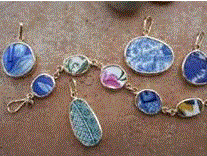In many ways STJ is an island living in the past; in the past and among the past. The traditional ways of doing things are still alive in daily living. The slow pace reflects the simplicity, and maybe the poverty, of the West Indian families who still own the land their freed ancestors farmed. Because the island is 2/3s (maybe more these days) preserved by the National Park and due to the lack of development in areas like the East End, it's like living in an archeological site. I've already mentioned that Athena finds artifacts in her garden all the time, they are everywhere. People use the finds to decorate stone walls. Pottery bits are made into jewelry on St, Croix. Kids would grind it on a wet rock shaping it into round "coins" to play with, called "Chaney" (change).
 |
| Chaney Jewelry |
The Park is responsible for the conservation and preservation of all the historical ruins - over 500 of them it's said - on 7000 acres, comprised of Danish roads, sugar plantations, houses, farms and rum factories. Time has stood still here and sometimes it's as if one day in 1870 everyone just got up and left. These old roads, built by enslaved labor, are the paved roads used today. Some are hiking trails, some are no more than footpaths people traveled from one end of the island to the other on foot or donkey. The ones I like to find are the ones forgotten in the bush. Where else can you wander for hours seeking treasure? Not gold and jewels, but ruins, pottery, terraces from sugar cane fields and gardens, rum bottles, the remains of lives with stories to tell. Like looking for a Lost City. Every plantation and household had a midden, a dump. If the dish broke they threw it out. "Trash" was dropped on the ground, dropped down the privy holes. Bottles were used to fill in stone walls. Everything just got tossed, then over time the rain washes away the soil disturbed further by goats' hoofed feet and these bits of treasure are revealed. For me!
Time to explore!
Disclaimer: Don't ask me where I went because then I would have to kill you. I found everything in my friend's and my backyards. All my intel comes from Top Secret sources.
I set out into the bush and immediately came upon substantial stone walls and a road.
I followed along, sometimes having to push my way carefully through razor-like thorny shrubs called Catch & Keep, dangerous ground cactus spines, pencil cactus that make your lips go numb if the sap gets on you, loose rocks, watching for wasp nests and orb spiders. Having fun yet? It was slow going but all the better to observe the landscape. The land gives up it's history if you look and a good detective has a watchful eye.
It's not always as obvious as seeing almost full sized bottles like the ones below. These are from the 1800's, they're hand blown with a punt in the bottom and pontil marks.Slavery was abolished on STJ around 1830, so these bottles could have been pre or post emancipation, but close enough.
It wasn't long before I came upon this small ruin. The stone floor and foundation had survived, the wooden lath and plaster was long gone. There was a door in each wall to let the breezes blow through. The doorway facing the bay far below opened to a stone retaining wall and a large patch of aloe. They would have had aloes near the house for medicinal use. Behind the house was what I thought had been an oven, there wasn't much left to tell. There is a plantation ruin near this site, but for numerous reasons, I decided this was a free man's house.

Not too far away were more bottles and earthenware pieces, maybe from a cooking pot. On the left is the bottom of a seamless dip-mold bottle, about 1850, commonly used for gin.
 |
| There were a lot of pottery shards and glass. |
 |
| This stone almost looks like it was used to grind flour, it had a deep rounded bowl shape. |
I have been playing Amateur Archeologist for almost 15 years. Finding these small souvenirs of these people long gone keeps them alive in spirit. Having a bottle, a tool, a piece of a teacup, is all that's left of their story, possibly one of challenge, homesickness, loss and sadness, but hope . They had to build this life on hope, they gave up everything for it. Sometimes when I'm sitting at one of these ruins, I can get a sense of happiness and peace, that the people here enjoyed their day as we do, had the same desires and needs as we do. Sometimes the ruins don't feel welcoming, as if the suffering and anger of the lives spent and destroyed there still linger. It's disturbing to think of the enslaved laborers who you can almost see in a shadow, sad to think of the plantation owners who put everything they had, and their family's existence, into a doomed venture in this paradise. You want to say "What were you thinking???"
But it's also a tale of perseverance, pride and strength, for the winners are the people who are still here today.
 |
| A Rum Crock |
 |
| Clay Pipe Pieces: Not Sure About the Cute Purple Crock |
 | ||||
| One of My Favorite Pottery Shards |



No comments:
Post a Comment